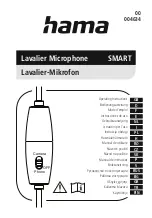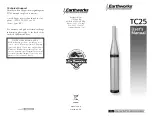
exposure to very strong wind. As a rule such
overload will not damage the microphone;
even strong wind blowing directly against the
capsule membrane will not harm it unless the
forces involved are enormous. A properly
powered
SCHOEPS
CMIT 5 U shotgun micro-
phone can normally handle 130+ dB sound
pressure levels. Such levels are hardly ever
reached by natural sound sources.
With a properly powered
SCHOEPS
micro-
phone not exposed to wind, any overloads will
occur far more often in a mixer or preamp's
input circuit than in the microphone itself. This
is particularly true with equipment that was
designed primarily for use with dynamic or
consumer-type microphones. Thus if distortion
can be heard when the cause is obviously not
wind, then one of the first tests might be to
plug in a balanced ”pad” (resistive attenuator
such as the
SCHOEPS
MDZ 10 or MDZ 20) at
the console or preamp input to see whether
that solves the problem. This type of pad is
superior to built-in pad switches.
Unfortunately, even with fully professional
equipment, ”overload” indicators cannot
always be relied upon to indicate input over-
load – many such indicators are wired only to
later stages in the circuitry.
If a preamp or mixer has an input sensitivity
control, it should be set for a good compromise
between avoiding input overload on the one
hand (sensitivity too high) and avoiding noise
on the other (sensitivity too low). Ideally a
mixer or preamp should not add any noise of
its own to a microphone's signals, but a dB or
two of hiss is better than gross distortion
caused by clipping.
Low-frequency disturbances such as wind
or vibration may not be perceived directly
(subsonic noise), but can still cause overload
in some stage of the signal chain. Low-fre-
quency noise can be effectively suppressed
using the Active in-line low-cut Filters LC 60
and LC 120. They can be placed between the
output of the microphone cable and the phan-
tom-powered input of a mixer, preamp or
recorder, thus protecting that input from over-
load.
Any other overload for which there seems
to be no sensible explanation may actually be
a symptom of incorrect or inadequate micro-
phone powering. Powering systems and their
requirements are discussed near the begin-
ning of this User Guide on page 19.
The most appropriate and most helpful trouble-
shooting tools are:
– a well-known good microphone cable
– a simple pop screen such as the
SCHOEPS
W 140 (or for outdoor recording, a wind
screen such as the
SCHOEPS
WSR CMIT U)
– a balanced, in-line resistive attenuator (”pad”)
such as the
SCHOEPS
MDZ 10 or MDZ 20
– an ordinary multimeter or the
SCHOEPS
PHS 48 phantom power tester
SCHOEPS
GmbH · Spitalstr. 20 · D-76227 Karlsruhe (Durlach) · Tel: +49 721 943 20-0 · Fax: +49 721 943 2050
www.schoeps.de · [email protected]
Troubleshooting
23
English
LC 60
or
LC 120
Active in-line low-
cut Filter
PHS 48
phantom
power tester
MDZ 10
resistive
attanuator

































